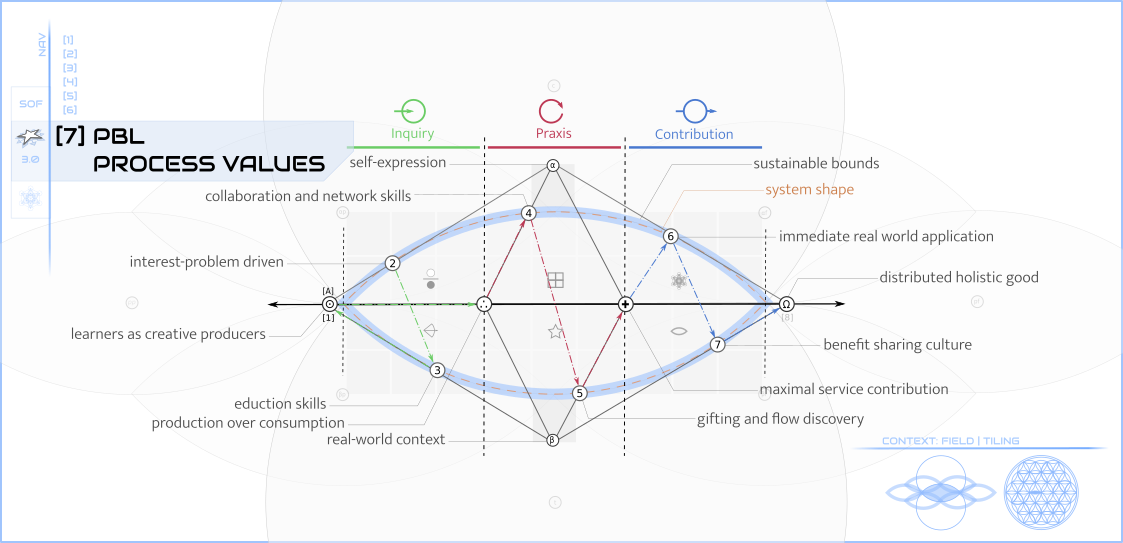
[7] PBL Process Values
PBL Process Values describes the values underlying the process of learning in Project-based Learning (PBL) according to the flow of a typical project.
PBL Process Values Matrix
Values for Creative Tension
(α) Self-expression: People have a fundamental human desire to make their internal experience visible to others and to interact with the external world in transformative ways. This is the Alpha or Push of PBL — the driving force behind the learners participation in the growing process. PBL seeks to reform educational experiences that are passive or domineering because they tend to exclude self-expression or limit it to predetermined acceptable forms. On the other hand, PBL seeks to connect self-expression to the real-world context through direct experience so that the outer reality can help clarify the inner reality and vice versa.1
(β) Real-world Context: When self-expression happens in dialog with the real-world context in which people live, both reality and the learner are clarified and real, valuable growth (learner) and change (world) can occur. This is the Beta or Pull that deepens and enriches PBL. People development outside the context of the real world — for example, if conducted exclusively in the “academy” of the Standard Education model — has been proven to be inefficient since our brains naturally forget information that is not used. Also, without the context of the real world, information cannot be connected properly to skills in order to produce holistic capacity in people and the systems they create. This is especially true as the evolution of technology and its impacts on human society create an environment of complexity through rapid, continuous, unpredictable change (something called “The Storm of Complexity”).
PBL uses to the creative tension between Self-expression and Real-world Context to create a space for true growth and synergizes a learner’s intended contribution and real situations to provide more radically useful and sustainable transformation to both learner and world. This flows from the value of all Learners as Creative Producers (⊙), with the hope of the end product of Distributed Holistic Good (Ω)2 for humanity and our world.
Zone 1: Inquiry (Planning It)
[1 ⊙] Learners as Creative Producers
“Salt and light”3
Learners should stay within a creative and productive role throughout the growing process so their holistic capacities grow in line with their identity and experiences. They believe they can and should change things for the better because they have actually done it.
(2) Interest-problem Driven
“See a need, fill a need.”4
Learning should be driven by the intersection of the learner’s interest and real-world problems in human understanding, practice, or experience and the impacts these problems have on the world. Transformative curiosity is driven by this creative tension and its ability to create a powerful story of growth.
(3) Eduction Skills
“It’s more fun to find it.”
Eduction is the process of uncovering and drawing out. Learning should always include the fun and wonder of discovery.5 People learn best when they did the work of gathering information and applying it, and building these skills fits better in a world of endless information. If a learner discovers they lack a capacity necessary for the project, they will see the need for the capacity and value it.
Zone 2: Praxis (Doing It)
(∴) Production over Consumption
“Always move towards making the change”
The first transitional value: people will show you they are ready for productive work when they say they believe they can actually move forward and start to enthusiastically build the process.
(4) Collaboration and Network Skills
“New connections = new solutons”
A process — like project execution — is a series of connected events and each event is marked by new connections between people, ideas, materials, etc. Therefore learners should always develop better skills in making relational, informational, and process connections to produce the most growth and best results.
(5) Gifting and Flow Discovery
“Only you can play your part”
There are many ways to do anything, but the best way is your way refined by continually improving practice. Every iteration of a process reveals more clarity about your capacities including your gifting and the style that helps you achieve optimal flow: doing it in a way that feels “natural”. The more a learner experiences this, the more they grow in confidence and understanding of their unique contribution.
Zone 3: Contribution (Spreading It)
(✛) Maximal Service Contribution
“Do the most good.”
The second transitional value: people are ready to share their project in the real world when you’ve refined their praxis for the maximum good: the most benefit, the greatest transportability, the most remarkable understanding or articulation.
(6) Immediate Real World Application
“Put rubber to the road.”
Learning gets locked in when people see the impact their project work has on the real world. Additionally, real-world feedback produces valuable, generative, and sustainable understandings of self, subject matter, and process. On top of all this, learning is a net gain because it efficiently translates into good in the world.
(7) Benefit-sharing Culture
“Spread the seeds of good”
Learners come to believe in their ability to produce value when the things they created in their project work — whether the intended products or the tools and knowledge they developed in the process — take on a life of their own and benefit others in new, unexpected, and beneficial ways.
Media

Related Entries
References & Notes
- Within consumerism has been a trend to produce identity-products (entertainment, fashion, meta/virtual reality, etc.) which allow consumers to “transcend” their identity without supposed reference external reality. However, these identity products then require the industry to manufacture a context — an artificial external reality — that then enslaves the consumer to a cycle of continuous redefinition by the manufacturer. Authentic self-definition is instead derived from a dialectical conversational within the real, shared reality that is non-derivative.
- This is most clearly articulated in the Jewish/Muslim concept of shalom — holistic well being and peace.
- A reference to Jesus’ pronouncement in Matthew 5:13-16.
- A quote from the character Bigweld from Big Sky’s Robots (2005).
- Many learners report that the Standard Model of Education makes them feel inferior and dis-empowered because it starts by displaying what they don’t know all that has already been uncovered.

